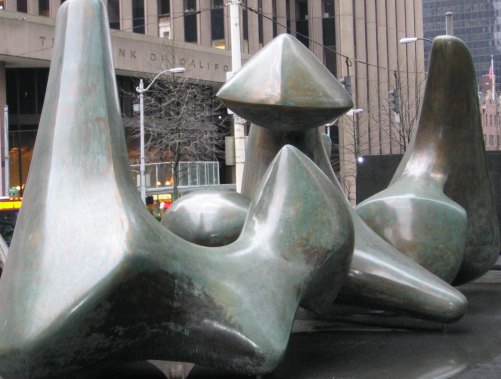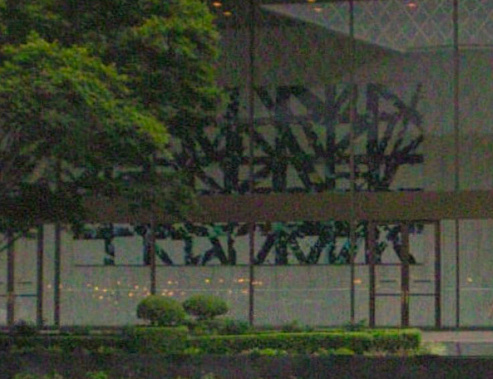Across the street from Rem Koolhaas’ Seattle Central Library is an
anonymous corporate building whose courtyard long sported incongruously
heavy-duty art credentials.
On the southwest corner is Henry Moore’s Vertebrae from 1968, in place since 1971.
 Behind and just north of Vertebrae a large acrylic abstraction by Sam Francis hung in the building’s lobby, fully visible from the street. It’s a grid undermined by splatters of colored light, 18.8 feet high and 26.6 feet wide, created in 1979 and purchased in 1980.
Behind and just north of Vertebrae a large acrylic abstraction by Sam Francis hung in the building’s lobby, fully visible from the street. It’s a grid undermined by splatters of colored light, 18.8 feet high and 26.6 feet wide, created in 1979 and purchased in 1980.
It’s gone now. Bank of America, its current owners, alerted nobody but the building’s tenants. Even they got only two days notice. This email arrived in their collective mailboxes on June 24 from Carsten Stehr, portfolio manager- NW Corporate Workplace,
Bank of America:
We wanted to make you aware that on June 26th, the Sam Francis painting
located in the lobby will be permanently removed to become part of the
bank’s Art in our Communities program and will initially be loaned to
the Mint Museum of Art in Charlotte, NC in conjunction with a large
exhibition of contemporary art from the bank’s collection.
The Francis is a last-minute addition at the Mint. On its website, the Mint doesn’t mention it. Stehr didn’t return several phone calls, but Britney Sheehan, media relations for the bank, did. She noted that instead of occupying several floors of the building, BofA is now limited to part of the lobby. Aside from joining the bank’s exhibit at the Mint, Francis’ painting has nothing else inked on its dance card. I asked Sheehan for an image. The next day, we had the following exchange.
Sheehan: We don’t have an image.
Me: You’ve owned the painting since 1980 and don’t have an image?
Sheehan: Yes.
Me: You can tell me that you won’t send me one, but you shouldn’t say you don’t have one. It isn’t believable.
Sheehan: An image is not available.
Below, a bad image from Google Earth:
 The bank has good reason for not wanting to share. In 1986, Seafirst Bank and JMB Management Company admitted that they had sold Vertebrae to a private collector in Japan. Both Seafirst and JMB were swamped by angry calls.
The bank has good reason for not wanting to share. In 1986, Seafirst Bank and JMB Management Company admitted that they had sold Vertebrae to a private collector in Japan. Both Seafirst and JMB were swamped by angry calls.
Linda Farris and David Mendoza organized protest marches and petitions. (“Henry Moore, he’s our man, we don’t want him to go to Japan.”) Unfavorable press coverage (largely from me) broke out of the arts section and began appearing on the front page. The city stepped in, blocking the sculpture’s removal on a technicality
(work permits were not in order).
After 8 tons of bad publicity over a two-month period, JMB and Seafirst
gave the Seattle Art Museum the money (twice the $1 million they’d received)
to buy back the sculpture from its new owner and guarantee it a
permanent Seattle home.
Will the Francis be sold after its star turn at the Mint? Nobody’s saying. Sheehan emphasized that the bank continues to support the arts in Seattle. She said in 2009 it donated $300,000 to arts in Seattle and Bellevue. In the last 10 years, she noted it has donated $900,000 to ArtsFund.
That’s an admirable past, but the loss of the Francis is a doleful comment on the future.



I’m sad Sam Francis has left Seattle, but I hope the painting finds a better home at the Mint. How well could anybody see it behind the lobby glass with all those heavy bands through it and trees in the way? Inside the lobby, there was no room to back up for a better view. If we had to pick between Henry Moore and Sam Francis, I’m glad we still have Henry.
Ah, for the old days, when Seattle managed to rouse itself to save a sculpture.